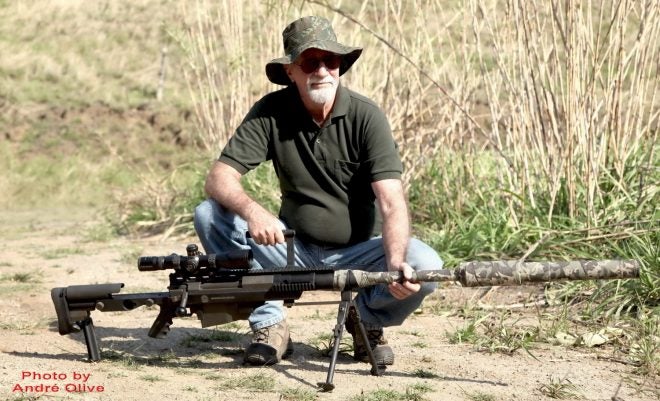It is generally accepted that the first serious attempts at using the .50BMG (or 12.7x99mm, if you’re into metrics) round for long-range sniping dates to the Vietnam War era, first using actual, scope-fitted Browning M2HB machine guns, and at a later stage some improvised bolt-action guns in that chambering. The whole thing would eventually lead to the U.S.-made Barrett family of guns that emerged in the early 1980s with the M82 “Light Fifty”, which would later become the M82A1 used by the American military in the Desert Shield and Desert Storm operations as the SASR – Special Applications Scoped Rifle for anti-materiel and ordnance disposal use. Since then, those heavyweight guns have proliferated worldwide in different calibers, configurations, origins, manufacturers, and, of course in use by varied operators. At the same time, the term HTI – Hard Target Interdiction has become generally accepted to describe the primary duties of such weapons, much more politically correct than simply blasting an enemy head from very far away.
One of such specialized guns comes from France: the Hécate II from the PGM Précision company, a long-time (over 20 years) developer and manufacturer of high precision rifles for the military, LE, and sports communities. The gun’s name comes from a goddess of Greek mythology, translating into English roughly as “she who operates from afar” or “she who launches darts far.” Enough said. It has been in active service with the French Army since 1993, with recent recorded combat participations in Afghanistan and Mali, for example. In addition to the country of origin, the “Greek Goddess” has also found its (her?) way into the inventories of several international forces, one of these being Brazil’s Corpo de Fuzileiros Navais (Marine Corps), whose Batalhão Tonelero, the SpecOps unit, some time ago allowed me to take a closer look at the gun, fire it, and bring some technical details to you.
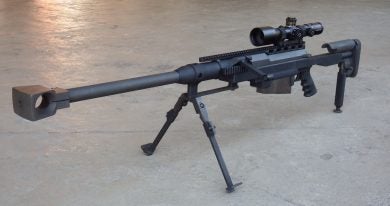
The .50BMG Hécate II is an ugly beast by most standards, but also highly accurate and destructive. Length overall, with the adjustable stock extended, is 1400mm, while weight is 16kg.
The rifle has a general skeletonized configuration that utilizes aircraft-grade aluminum alloy in its girder chassis, but featuring a tempered-steel receiver to cope with the high pressures generated by the .50 BMG round. The receiver, incidentally, has overpressure vents to protect the shooter from powder gases in the event of a cartridge case rupture. The match-grade, fully free-floating barrel is 700mm long, has a tapered profile and eight-groove, 1:15-inch-twist rifling, claimed by the manufacturer to have a lifetime of 12,000 shots. A large reverse-flow muzzle brake reduces felt recoil by around 50 percent, and this can be easily removed in the field with the use of a hex key to install a dedicated PGM-made suppressor, the QMS-50. This unit is 470mm long (extending the gun’s overall length to 1800mm) and weighs 3.9kg, which brings up the Hecate II’s weight to just over 18kg. A foldable carrying handle is provided for carrying the bulky weapon. The removable (for transportation purposes), length-adjustable stock has an equally-adjustable cheek rest, plus a folding butt spike and a fully-regulating bipod for stabilization. A Picatinny tri-rail structure is provided. The top rail, where a Schmidt & Bender 3-12x50mm PMII scope is fitted, is of an extended type to allow for add-on items, such as a Carl Zeiss NSV 600 night sight, as available for the Brazilian Marines’ guns. Operation of the Hécate II is of the conventional bolt-action type, the weapon feeding from a detachable seven-round steel magazine.
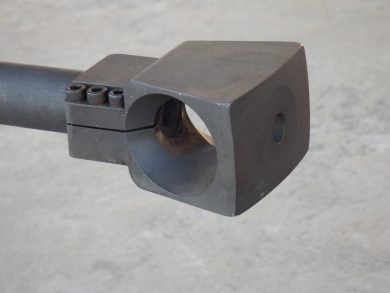
Up-close view of the massive muzzle brake. Its simple removal with the use of a hex key allows the dedicated sound suppressor to be quickly attached.
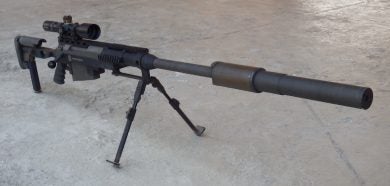
With the sound suppressor in place, the gun becomes 1800mm long and weighs 18kg, a price for maximum tactical effectiveness.
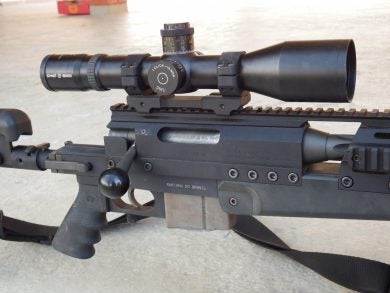
The scope used in the Brazilian Marines’ guns is the German-made Schmidt & Bender 3-12x50mm PMII with a first-focal-plane reticle, thus permitting adequate distance evaluations all the way out to 1,500 meters. Note barrel fluting just ahead of the chamber area.
Having learned that trained marksmen using the Hécate II do regularly shoot with accuracy at 1,500-1,800 meters in the anti-materiel role, I was more than anxious to lay my hands on the French beast. No, sir, I’m NOT a trained marksman, just a very plain shooter/scribe who frequently fires different guns! And there I was in the field with a bunch of “navais” (how the local leathernecks are usually called) to fire the gun, not in a very technical, serious test routine, but rather to have a general feel of it. To make my appraisal writing on the PGM Hécate II concise:
- The gun is heavy and bulky, not intended as a weekend toy for a 75-y-o senior.
- Once in position for firing, the bolt is pretty smooth to operate, the rounds feed effortlessly, and the factory-adjusted, two-stage trigger pull is 1-1.5kg.
- When firing, the huge muzzle brake turns the recoil generated by the .50BMG round into a viable proposition, while at the same time generating considerable side blast for bystanders and raising dust and debris (don’t forget to take the appropriate concealment steps, when in enemy grounds!)
- The massive sound suppressor makes the gun longer and heavier, but is a great asset to make your actions behind enemy lines as inconspicuous as possible. Oh, yes: it does increase felt recoil. I had a light scope bite to prove that, since I had not properly adjusted the butt’s length to my size.
- I consistently blasted some rocks situated uphill from my firing position about 350-400 meters away, the farthest distance available that day.
- I loved it!
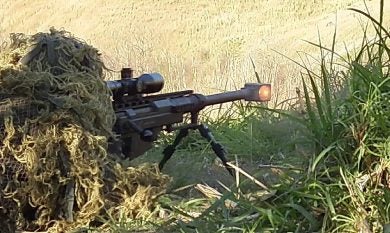

Sequential screen captures of a Batalhão Tonelero sniper firing the Hécate II, hot gases hitting the muzzle brake and some dust and debris following.
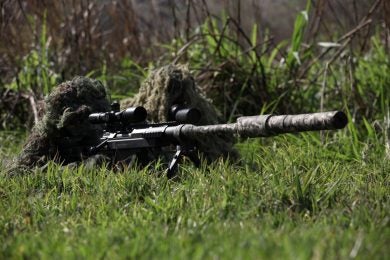
Sound-suppressed Hécate II, sniper & spotter: one helluva fighting trio.
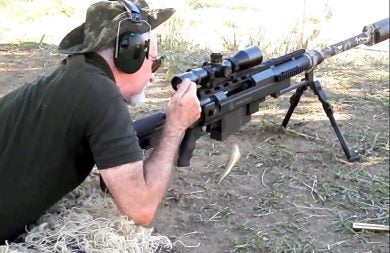
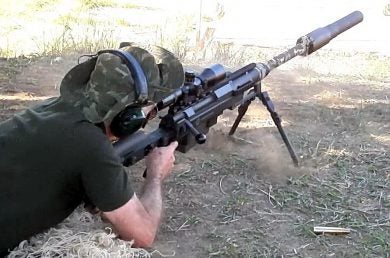
Author in the field blasting some uphill rocks with a suppressor-equipped Hécate II. Scope bite was earned in this series of shots … Adjust the stock, buddy! (Images by André Olive)
 Your Privacy Choices
Your Privacy Choices
